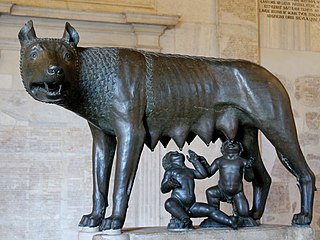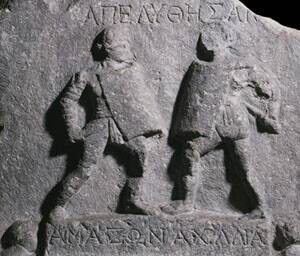
The Roman Republic was the era of classical Roman civilization beginning with the overthrow of the Roman Kingdom and ending in 27 BC with the establishment of the Roman Empire. During this period, Rome's control expanded from the city's immediate surroundings to hegemony over the entire Mediterranean world.

The pontifex maximus was the chief high priest of the College of Pontiffs in ancient Rome. This was the most important position in the ancient Roman religion, open only to patricians until 254 BC, when a plebeian first held this position. Although in fact the most powerful office in the Roman priesthood, the pontifex maximus was officially ranked fifth in the ranking of the highest Roman priests, behind the rex sacrorum and the flamines maiores.

The Senate was the governing and advisory assembly of the aristocracy in the ancient Roman Republic. It was not an elected body, but one whose members were appointed by the consuls, and later by the censors, which were appointed by the aristocratic Centuriate Assembly. After a Roman magistrate served his term in office, it usually was followed with automatic appointment to the Senate. According to the Greek historian Polybius, the principal source on the Constitution of the Roman Republic, the Roman Senate was the predominant branch of government. Polybius noted that it was the consuls who led the armies and the civil government in Rome, and it was the Roman assemblies which had the ultimate authority over elections, legislation, and criminal trials. However, since the Senate controlled money, administration, and the details of foreign policy, it had the most control over day-to-day life. The power and authority of the Senate derived from precedent, the high caliber and prestige of the senators, and the Senate's unbroken lineage, which dated back to the founding of the Republic in 509 BC. It developed from the Senate of the Roman Kingdom, and became the Senate of the Roman Empire.

The patricians were originally a group of ruling class families in ancient Rome. The distinction was highly significant in the Roman Kingdom and the early Republic, but its relevance waned after the Conflict of the Orders. By the time of the late Republic and Empire, membership in the patriciate was of only nominal significance. The social structure of ancient Rome revolved around the distinction between the patricians and the plebeians. The status of patricians gave them more political power than the plebeians but the relationship between the groups eventually caused the Conflict of the Orders. This time period resulted in changing the social structure of ancient Rome.
Gaius Sempronius Gracchus was a reformist Roman politician and soldier who lived during the 2nd century BC. He is most famous for his tribunate for the years 123 and 122 BC, in which he proposed a wide set of laws, including laws to establish colonies outside of Italy, engage in further land reform, reform the judicial system and system for provincial assignments, and create a subsidised grain supply for Rome.

Various lists regarding the political institutions of ancient Rome are presented. Each entry in a list is a link to a separate article. Categories included are: constitutions (5), laws (5), and legislatures (7); state offices (28) and office holders ; political factions and social ranks (8). A political glossary (35) of similar construction follows.

The College of Pontiffs was a body of the ancient Roman state whose members were the highest-ranking priests of the state religion. The college consisted of the pontifex maximus and the other pontifices, the rex sacrorum, the fifteen flamens, and the Vestals. The College of Pontiffs was one of the four major priestly colleges; originally their responsibility was limited to supervising both public and private sacrifices, but as time passed their responsibilities increased. The other colleges were the augures, the quindecimviri sacris faciundis , and the epulones.

Latin rights were a set of legal rights that were originally granted to the Latins under Roman law in their original territory and therefore in their colonies. "Latinitas" was commonly used by Roman jurists to denote this status. With the Roman expansion in Italy, many settlements and coloniae outside of Latium had Latin rights.

The Curiate Assembly was the principal assembly that evolved in shape and form over the course of the Roman Kingdom until the Comitia Centuriata organized by Servius Tullius. During these first decades, the people of Rome were organized into thirty units called "Curiae". The Curiae were ethnic in nature, and thus were organized on the basis of the early Roman family, or, more specifically, on the basis of the thirty original patrician (aristocratic) clans. The Curiae formed an assembly for legislative, electoral, and judicial purposes. The Curiate Assembly passed laws, elected Consuls, and tried judicial cases. Consuls always presided over the assembly. While plebeians (commoners) could participate in this assembly, only the patricians could vote.

The gladiatrix is the female equivalent of the gladiator of ancient Rome. Like their male counterparts, gladiatrices fought each other, or wild animals, to entertain audiences at various games and festivals. Very little is known about them. They seem to have used much the same equipment as male gladiators, but were heavily outnumbered by them, and were almost certainly considered an exotic rarity by their audiences. They seem to have been introduced during the very late republic and early empire, and were officially banned as unseemly from 200 AD onwards. Their existence is known only through a few accounts written by members of Rome's elite, and a very small number of inscriptions.
In ancient Rome, the principle of private association was recognized very early by the state. Sodalitates for religious purposes are mentioned in the Twelve Tables, and collegia opificum, or trade guilds, were believed to have been instituted by Numa Pompilius, which probably means that they were regulated by the jus divinum as being associated with particular cults.
The lex Gabinia, lex de uno imperatore contra praedones instituendo or lex de piratis persequendis was an ancient Roman special law passed in 67 BC, which granted Pompey the Great proconsular powers in any province within 50 miles of the Mediterranean Sea without holding a properly elected magistracy for the purpose of combating piracy. It also gave Pompey the power to appoint many legates and significant financial resources. The law was proposed and passed by the tribune Aulus Gabinius.
A burial society is a type of benefit/friendly society. These groups historically existed in England and elsewhere, and were constituted for the purpose of providing by voluntary subscriptions for the funeral expenses of the husband, wife or child of a member, or of the widow of a deceased member. Some also allowed for insuring money to be paid on the death of a member.

A collegium, or college, was any association in ancient Rome that acted as a legal entity. Such associations could be civil or religious. The word collegium literally means "society", from collega ('colleague'). They functioned as social clubs or religious collectives whose members worked towards their shared interests. These shared interests encompassed a wide range of the various aspects of urban life; including political interests, cult practices, professions, trade, and civic services. The social connections fostered by collegia contributed to their influence on politics and the economy; acting as lobbying groups and representative groups for traders and merchants.
The lex Calpurnia de repetundis was a Roman law sponsored in 149 BC by the tribune of the plebs Lucius Calpurnius Piso. It established the first permanent criminal court in Roman history, in order to deal with the growing number of crimes committed by Roman governors in the provinces. The lex Calpurnia was a milestone in both Roman law and politics.

The Roman Constitution was an uncodified set of guidelines and principles passed down mainly through precedent. The Roman constitution was not formal or even official, largely unwritten and constantly evolving. Having those characteristics, it was therefore more like the British and United States common law system than a sovereign law system like the English Constitutions of Clarendon and Great Charter or the United States Constitution, even though the constitution's evolution through the years was often directed by passage of new laws and repeal of older ones.
The Valerian and Porcian laws were Roman laws passed between 509 BC and 184 BC. They exempted Roman citizens from degrading and shameful forms of punishment, such as whipping, scourging, or crucifixion. They also established certain rights for Roman citizens, including provocatio, the right to appeal to the tribunes of the plebs. The Valerian law also made it legal to kill any citizen who was plotting to establish a tyranny. This clause was used several times, the most important of which was its usage by Julius Caesar's assassins.

The Roman Assemblies were institutions in ancient Rome. They functioned as the machinery of the Roman legislative branch, and thus passed all legislation. Since the assemblies operated on the basis of a direct democracy, ordinary citizens, and not elected representatives, would cast all ballots. The assemblies were subject to strong checks on their power by the executive branch and by the Roman Senate. Laws were passed by Curia, Tribes, and century.

The Tribal Assembly was an assembly consisting of all Roman citizens convened by tribes (tribus).
The Lex Pompeia de Transpadanis was a Roman law promulgated by the Roman Consul Pompeius Strabo in 89 BC. It was one of three laws introduced by the Romans during the Social War between Rome and her Socii (allies), where some of Rome's Italic allies rebelled and waged war against her because of her refusal to grant them Roman citizenship. This law dealt with the local communities in Transpadana, the region north of the River Po,. It granted Latin Rights to these peoples as a reward for siding with the Rome during the Social War. This gave the inhabitants of the region the legal benefits associated with these rights, which were previously restricted to the towns of Latium which had not been incorporated into the Roman Republic and to the citizens of Latin colonies. They included: A) Ius Commercii, "a privilege granted to Latin colonies to have contractual relations, to trade with Roman citizens on equal terms and to use the form of contracts available to Roman citizens". It also allowed contracts and trade on equal terms with citizens of another Latin towns. B) Ius Connubii, was the right to conclude a marriage recognised by law, ius connubii of both parties was necessary for the validity of the marriage. Later it was extended to citizens of foreign communities "either generally, or by special concession". In the case of Latin rights it made marriages between citizens of different Latin towns legal. C) Ius migrationis, the right to retain one’s level of citizenship if the individual relocated to another city. In other words, it facilitated migration by the acquisition of citizenship of another Latin town. In addition to this, the law granted Roman citizenship to the magistrates (officials) of the local towns.








